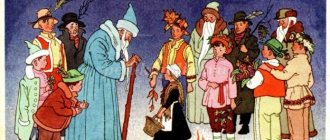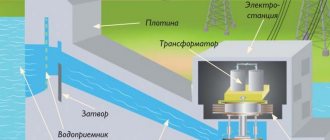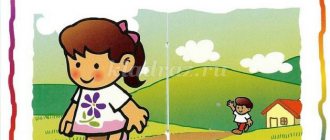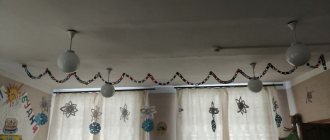Summary of an integrated lesson for children 6-7 years old on the topic: Seasons
Description of the material: The lesson is aimed at consolidating knowledge and ideas about the season, its features and signs. Specifics of the lesson: clarity, compactness, high information content of the educational material, due to which one of the basic principles of preschool didactics is implemented - the lesson should be small in volume, but capacious, which is possible with an integrative approach, when a specific subject or phenomenon is considered from several sides in different ways. aspects; a large number of different visual materials and attributes are used; switching to a variety of activities helps to keep children’s attention, which increases the effectiveness of the lesson, relieves fatigue and overstrain. The “main thread” of this integrated lesson is the music of the seasons – color – a person’s mood. The selected material and technical support made it possible to maintain the children’s interest throughout the entire activity. Program content: • Develop children's creativity in visual, musical, speech and theatrical activities; • Enrich the vocabulary with emotional and evaluative vocabulary; • To instill in children a sense of beauty, a love of nature and their native land. Preliminary work: listening to “Winter” by A. Vivaldi, the play “The Bells Are Ringing” by W. Mozart, the play “Waltz of Snow Flakes” from the ballet “The Nutcracker” by P. I. Tchaikovsky; viewing reproductions: “February Azure” by I.E. Grabar, “Winter” by I.I. Shishkin, “Vyuzhit. Blizzard" A.M. Vasnetsov; conversation on the topic “What is mood and does nature have it?”; artistic and educational game “Guess the mood”; reading poems about winter. Developmental environment: reproductions of paintings: “February Azure” by I.E. Grabar, “Winter” by I.I. Shishkin, “Blizzard” by K.A. Korovin; synthesizer, multimedia installation, music for relaxation (disc), music center, piano, children's musical instruments; glass with processed edges, white gouache, brushes, napkins, jars of water, an exhibition of children's drawings about winter. Methods and techniques: informative - receptive (examination, observation); verbal (conversation, story, artistic expression), heuristic, TSO, ICT. CONTENT
Children enter the hall to the music and stand near the chairs.
Teachers: Hello, guys! Let's greet each other with a song! Chant - greeting "Good afternoon" children sit down Teacher (draws attention to the exhibition of drawings about winter): Guys, look, today we have an exhibition of drawings in the music room. — What time of year is depicted on them? - Name the winter months (children's answers) - Do you like winter? Why? — Are all winter days alike? — What is the weather like in winter? Teacher: Poets, artists, composers convey the mood of winter in colors, poems, and music. Look at these pictures. They look at the paintings: 1) “February Blue” by I.E. Grabar 2) “Winter” by I.I. Shishkin 3) “It’s blowing.” Blizzard" A.M. Vasnetsov Conversation: What is depicted? Remember what it's called? What is the mood of the picture? Teacher: In the works of composers and poets, winter is also very different: with thaw, and with snowstorms, and snowy, and sunny. You and I know a song about winter. (They get up and sing the song “White Winter”, music and lyrics by L. Kuklina)) Musical director: Winter is perhaps the most magical time of the year. She gives us the most fun games, the most interesting fairy tales on long winter evenings. In one night, winter can create a completely new picture in nature. The poem “Winter Morning” by A.S. sounds. Pushkin against the backdrop of music and at the same time showing slides with winter landscapes. Musical director: Now listen to the music (“Winter” by A. Vivaldi, excerpt). Musical Director: Did you recognize her? Musical director: Correct. This musical work by composer A. Vivaldi is called “Winter”. Musical director: What natural phenomenon do you think the composer depicted? Let's get creative. Children assume that it is a blizzard, a blizzard, or a strong wind. Musical director: Indeed, it was as if a strong wind blew and a blizzard swirled. Teacher: It seems to me that there was even a whiff of cold... Yes, it was the Snow Queen herself who rushed by! Do you want to fly after her? Then imagine that we have invisible hats, we will put them on and close our eyes. Children pretend to put on invisible hats and close their eyes. Teacher (recites to the sound of the wind). The weather began to rustle, the weather cleared up in the field, and the smooth road was covered with white snow. Covered with white snow. not a trace to be seen. Dust and a blizzard rose, and there was no light left. Teacher: Open your eyes. And here we are at the Snow Queen. In her snowy kingdom it is very cold, everything is covered in ice. You and I can also turn into ice figures. Musical game “Ice Figures” (Children perform various movements to the music. At the end of the music, they “freeze.” The teacher must guess what kind of figure it is. At the end of the game, the children sit down). Teacher: Hush, hush! Do you hear? A chime can be heard from somewhere. The play “The Bells Are Ringing” by W.A. Mozart (synthesizer) Teacher: Who in the kingdom of the Snow Queen could have such a voice? Children describe the voice they hear: fabulous, light, crystal, magical, extraordinary, ringing, glassy, cold. Musical director: Maybe these snowflakes are the servants of the Snow Queen? They talk like this, touching each other with crystal rays. And now I invite you to play. Didactic game “What sounds” (Children are asked to choose from alternately sounding instruments the one that resembles the voice of crystal snowflakes (metallophone, triangle, bell, tambourine, xylophone, etc.) Teacher: Look at the snowflakes, how different they are: round, shaggy , with sharp rays, etc. (They look at the snowflakes on the screen)
But then amazing music flowed around, the snowflakes began to spin in a round dance. An excerpt from the ballet “The Nutcracker” by P.I. Tchaikovsky “Waltz of the Snow Flakes” is playing.
Teacher: We are with you Let's also try to dance like snowflakes. The children are spinning in the dance like snowflakes (improvisation}
Teacher.
Well done, you danced very beautifully, but it's time for us to return to kindergarten. Let's close our eyes and slowly take off our invisible hats. Children close their eyes and "remove" the invisibility hats. Teacher: Well, here we are again in the music room. And now I invite you to draw different, unusual in shape, light snowflakes on the glass. Children come up to the tables, while listening to the music they draw different snowflakes on the glass with gouache, Frost patterns. (Music for relaxation) After finishing the work, the children walk around and look at the drawings. Teacher: Well done! Guys, did you like our trip? What did you like most? We also really liked the way you sang, danced, and drew. Winter is truly a wonderful time of year, but it is coming to an end, and in a year it will again delight us with magical snow patterns, beautiful snowflakes and different songs of blizzards.
We recommend watching:
Summary of an integrated lesson in a preparatory group with general speech underdevelopment of the third level. Summary of an integrated lesson in a preparatory group. A rocket flies into space Integrated lesson in the preparatory group. Space travel Summary of an integrated lesson - exhibition in the preparatory group of a preschool educational institution
Similar articles:
Summary of an integrated lesson in the group of software “Alien from an unknown planet”
Lesson summary – travel on the topic “School” in the preparatory group
Summary of the lesson “Take care of nature” in the preparatory group





